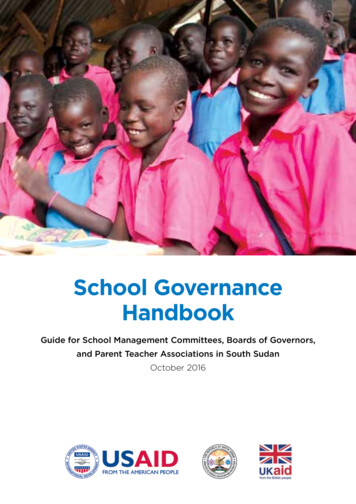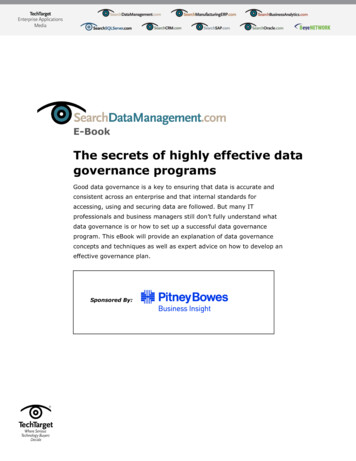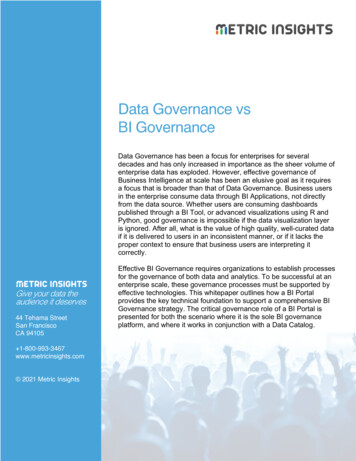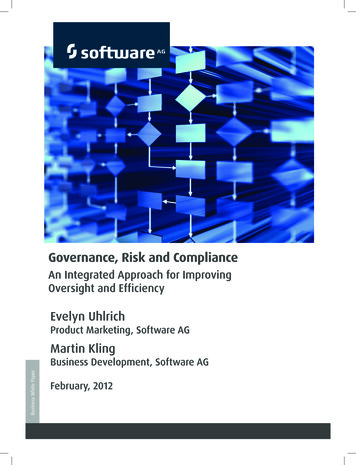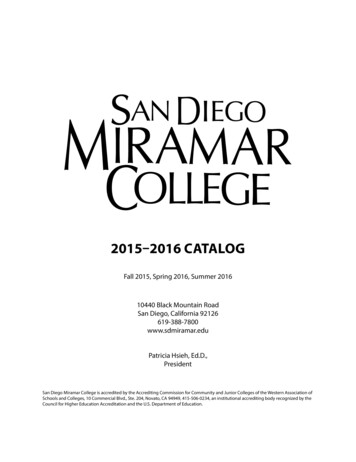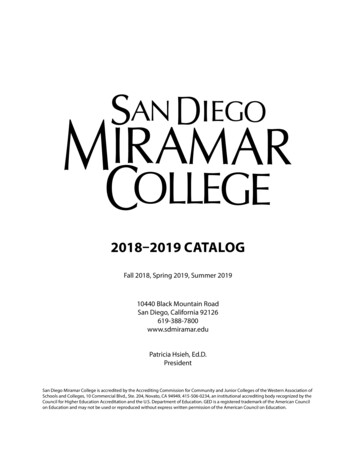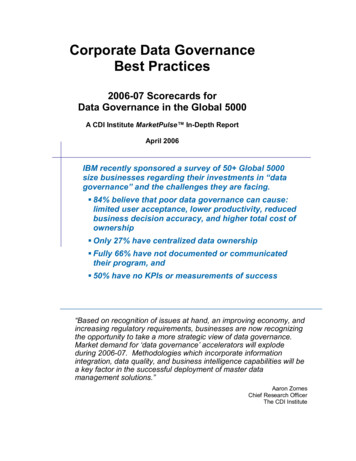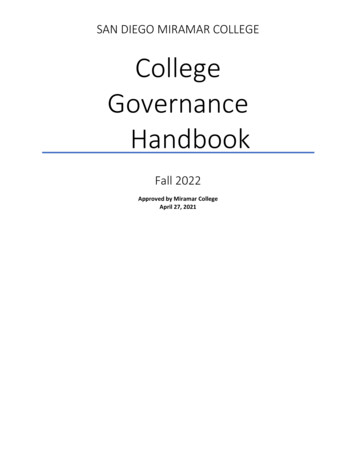
Transcription
SAN DIEGO MIRAMAR COLLEGECollegeGovernanceHandbookFall 2022Approved by Miramar CollegeApril 27, 2021
Table of ContentsPreamble . 4College Mission . 4Vision . 4Purpose of Governance Structure . 5Guiding Principles . 5San Diego Miramar College Governance and Organizational Structure . 6Participatory Governance. 6Faculty . 7Classified Professionals . 7Students. 8Administrators . 8Participatory Governance Committee Processes and Roles . 9Role of the Chair/Co-Chairs . 10Role of the Committee Member . 12Committee Membership Appointment and Term Lengths. 15Committee Reporting and Recommendations . 17Participatory Governance Committees . 18College Council . 18Grants and Initiatives Subcommittee . 21Standing Committees of College Council . 23Inclusion, Diversity, Equity and Anti-Racism Committee . 23Enrollment Management Committee . 25Facilities, Health, and Safety Committee . 27Environmental Sustainability Subcommittee . 29Guided Pathways Committee . 30Marketing and Outreach Committee . 32Planning, Institutional Effectiveness, and Research . 34Budget and Resource Development Subcommittee . 36Program Review and Outcomes Assessment Subcommittee . 38Professional Development Committee . 40Student Services Committee . 42Technology Committee . 44Collegial Consultation with the San Diego Miramar College Academic Senate . 46Academic and Professional Matters . 46Standing Committees for the Academic Senate. 47Academic Senate Equivalency Committee . 47Academic Success Committee. 48Chairs Committee . 502
. 51Contract Faculty Hiring Prioritization Committee . 51Curriculum Committee . 53Academic Standards Subcommittee . 55Curriculum Technical Review Subcommittee. 57. 59Distance Education Standards Committee . 59. 61Success in English, ELAC, and Math (SEEM) Committee . 61Operational Committees . 63Review of Services . 63Hourglass Joint Use Committee . 63Professional Advancement Committee . 63Advisory Committees. 63College-wide Decision Making Structure Chart . 64. 64Figure 1. The chart above shows the organization of the College Governance Committees at San Diego MiramarCollege, and the reporting structure for each committee under the two categories of committees; Academic Senate andParticipatory Governance. The reporting process and direction are shown by the arrows and lines, culminating indeliberative decisions made by the College President in consultation with both the Academic Senate and the CollegeCouncil. There are also Operational Committees within the College (not shown here but listed in Appendix D). The roleof operational committees is to implement the recommendations that have been approved by the College through thecollege governance committees seen here. . 64*Curriculum committee is a decision making committee. . 64Appendices . 65Appendix A: Rules and Tools . 65Meeting Rules of Engagement . 65Meeting Management Tools . 66Appendix B: Forms and Templates . 67Proxy Form - San Diego Miramar College Governance Committees . 67Committee Meeting Agenda Template . 68Committee Meeting Minutes Template . 69Appendix C: Glossary and Resources . 70Appendix D: Groups in Governance. 72Standing Committee . 72Executive Committee . 72Subcommittee . 72Steering Committee . 72Taskforce . 73Advisory Group . 73Appendix E: Operational Committees at San Diego Miramar College . 74Appendix F: San Diego Community College District Committees. 753
PreambleIn compliance with AB 1725 (1988) and the California Code of Regulations §§ 51023, 51023.5,51023.7, it shall be the policy of San Diego Miramar College to implement a process whereinfaculty, students, classified professionals, and administration participate in collegial decisionmaking and policy recommending activities.College MissionSan Diego Miramar College's mission is to prepare students to succeed by providing qualityinstruction and services in an environment that supports and promotes success, diversity,inclusion, and equity with innovative programs and partnerships to facilitate student completionfor degrees/certificates, transfer, workforce training, and/or career advancement.VisionSan Diego Miramar College will be the center of education, innovation, and services to supportour diverse students and community.San Diego Miramar College, in keeping with this vision, supports and emphasizes the followingguiding values: Access to learning and support services, for all students to successfully achieve their educational and career goalsA culture that embraces and promotes equity, inclusion, civility, responsibility and,sustainability, from a global perspectiveDiversity, equity, inclusion, and success of our students, classified professionals, faculty,administrators, and programs that reflect our communityCreativity, innovation, flexibility, and excellence in teaching, learning, and servicesThe ability to recognize and respond to opportunities and challenges emerging from a complexand dynamic worldStrategic resource and partnership development to support curriculum and programinnovationCollaboration and partnershipsEffective participation in governance with respect and professionalism, through intentional,purposeful, and effective communication embraced by the college communityTransformative processes that include a culture of evidence, data-driven decision making,collaborative inquiry, and action for promoting student success4
Purpose of Governance StructureSan Diego Miramar College strives to enhance student success, improve the student experience,and ensure equitable access and outcomes for all students. Effective participatory governancewill support these outcomes and will create a trustworthy recommendation-making process. Thishandbook is designed to clarify the role of faculty, classified professionals, students, andsupervisors/administrators in participatory governance at San Diego Miramar College. It providesguidance on the roles and responsibilities of all members of the college community, whether oneis serving on a governance body or not. It also describes the recommendation and decision-makingprocess, and how members of college constituency groups and governance bodies participate inthat process.The governance structure at San Diego Miramar College is designed to:1. Implement the mission of the College through compliance with AB 1725 (1988).2. Provide the opportunity for input from all college constituencies.3. Ensure appropriate consultation and feedback.4. Create a process to promote open communication between the constituencies.5. Base the recommending process on open communication and shared information.6. Encourage all to hear and respect the needs and expectations of faculty, classifiedprofessionals, students, and administrators in a consensus-building atmosphere.7. Ensure diverse opinions and perspectives in governance.Guiding PrinciplesThe San Diego Miramar College Governance procedures are based on the following key assumptions:1. This governance structure has been established first and foremost to further theeducational goals of San Diego Miramar College students. To accomplish this, we value anddepend upon the commitment and communication of everyone. Therefore, this modelinvites the effective participation of the faculty, classified professionals, students, andadministrative staff of San Diego Miramar College through their officially recognizedconstituent groups, respectively: the Academic Senate, the Classified Senate, theAssociated Student Government, and the College President. Conflict resolution, if any,shall take place in a collegial and professional manner (see District Board Policy 7150:Civility and Mutual Respect).2. The governance structure of San Diego Miramar College should remain dynamic, flexible,and modifiable to accommodate campus needs as well as changing situations, policies,laws, and responsibilities defined at the District and State levels.3. The governance structure is designed to implement the San Diego Miramar Collegemission and goals. Thus, the campus goals will be the focus for all recommendations.4. This governance model has been developed to facilitate recommendations and to complywith AB 1725 and Title 5, §§ 51023, 51023.5, and 51023.7, of the California Code ofRegulations, 70902(b)(7) of the California Education Code, and Accreditation Standards.5
San Diego Miramar CollegeGovernance and OrganizationalStructureThe Board of Trustees, Chancellor of the District, and the College President provide leadership incarrying out the mission of the District and the College. The Board of Trustees has decisionmaking authority over all policy matters and designates the operation of the District to theChancellor who delegates authority to the College President for the operation of the College. TheSan Diego Miramar College governance and organizational structure has four distinctcomponents:Administrative matters; labor relations managed at the District level; Academic and ProfessionalMatters; and participatory governance. Administrative MattersAdministrative matters that do not fall in the participatory governance category and canderive from a variety of sources, including administrative units, college committees,individuals, and community members, are forwarded to the College President for routingto the appropriate recommending body. Labor RelationsLabor relations is outlined in the Educational Employees Relations Act and managed atthe District level. Academic and Professional MattersAs defined in California Ed Code, Title 5, §§ 53200-53206, all Academic and ProfessionalMatters are in the purview of the Academic Senate. Participatory GovernanceParticipatory governance as set forth in AB 1725 (1988) requires the participation of allfour constituency groups.Participatory GovernanceFor the inclusion of all four constituency groups in participatory governance, San Diego MiramarCollege has established the College Council as the official recommending body for the College.The College recognizes that diverse opinions and values are important and that the knowledgeand experience of faculty, classified professionals, students, and administrators are essential tothe successful operation of the College. Therefore, participation in governance is encouraged,expected, and supported by the College and serves as an opportunity for, and responsibility ofall employees. In addition to the constituency roles in participatory governance committees, thestatue specifically assigns these rights and responsibilities.6
FacultyThe Academic Senate is established by Board Policy 0210 as the mechanism throughwhich the faculty voice their formal and effective participation in makingrecommendations to the administration of the College and to the Governing Board (Boardof Trustees) on formation and implementation of District and College policies onAcademic and Professional Matters (10 1) and on other District policies and proceduresas stipulated in Title 5, §§ 53200 and 53203 as well as those contained in statute or otherregulations.The Board of Trustees recognizes the authority of the Academic Senate as representingthe position of the faculty regarding Academic and Professional Matters in accordancewith applicable state laws and regulations. The Board of Trustees or its designee(s) willconsult collegially with the Academic Senate, as duly constituted, with respect to thefollowing Academic and Professional Matters as defined by law.1.Curriculum, including the establishment of prerequisites and placing courseswithin disciplines;2. Degree and certificate requirements;3. Grading policies;4. Educational program development;5. Standards or policies regarding student preparation and success;6. District governance structures as related to faculty roles;7. Faculty roles and involvement in accreditation processes,8. Policies for faculty professional development activities;9. Processes for program review;10. Processes for institutional planning and budget development; and11. Other Academic and Professional Matters as mutually agreed upon between theBoard of Trustees and the Academic Senate, which includes, but is not limitedto, faculty hiring processes.Classified ProfessionalsThe Classified Senate is established as the mechanism through which the classifiedprofessionals voice their formal and effective participation in making recommendationsto the administration of the College. As stipulated in Title 5, § 51023.5, classifiedprofessionals “shall be provided with opportunities to participate in the formulation anddevelopment of District and College policies and procedures, and in those processes forjointly developing recommendations for action by the Governing Board (Board ofTrustees), that the Governing Board reasonably determines, in consultation with staff,have or will have a significant effect on staff”. The College Council and participatorygovernance committees are the venues through which classified professionals are giventhat opportunity at San Diego Miramar College in alignment with Board Policy 2510.7
StudentsStudents are represented through the Associated Student Government of San DiegoMiramar College. As stipulated in Title 5, § 51023.7, and by Board Policy 2510, studentsparticipate in college policies and procedures that have a direct impact on them to includethe following:1. Grading policies;2. Codes of student conduct;3. Academic disciplinary policies;4. Curriculum development;5. Courses or programs that should be initiated or discontinued;6. Processes for institutional planning and budget development;7. Standards and policies regarding student preparation and success;8. Student services planning and development;9. Student fees within the authority of the District to adopt; and10. Any other District and College policy, procedure, or related matter that the DistrictGoverning Board determines will have significant effect on students.AdministratorsManagers and supervisors shall have the opportunity to participate in the formulation ofCollege policies and procedures and other areas.Commonly used Abbreviations for Schools/Divisions at San Diego Miramar College Business Technical Careers Workforce Initiatives (BTCWI) Liberal Arts (LA) Mathematics, Biological, Exercise and Physical Sciences (MBEPS) Planning, Research, Institutional Effectiveness, Library and Technology (PRIELT) Public Safety (PS)Evaluation Methods and Cycle for the College Governance HandbookPer Accreditation Standards (IV.B. and IV.A.), the San Diego Miramar College GovernanceOrganizational Structure and Processes are evaluated in order to ensure continuousimprovement of the institution. As per the College Governance Committee (CGC)recommendation (2018), currently the evaluation method for the College GovernmentSystem is operating in a three-year cycle. In alignment with the current evaluation cyclefor the College Government System, it is recommended by CGC that the CollegeGovernance Handbook (CGH) follow the same three-year cycle for input, feedback, vetting,recommendations and implementation of changes.8
Participatory Governance CommitteeProcesses and RolesThe College participatory governance committees’ function to gather information, analyze andmake proposals, and develop reports and recommendations to the constituent groups through aprocess of research and collegial discussion. These committees make recommendations to theCollege Council for final resolution.All meetings of participatory governance committees shall be open to everyone, and any memberof the college community is invited to attend any meeting as a guest at any time. Members ofcommittees are charged with consulting, polling, informing, and representing theirconstituencies. Each constituent group will establish selection criteria and appointrepresentatives to participatory governance committees. The respective constituency groups willalso fill vacancies and replace members who do not attend meetings regularly.The Academic Senate, Associated Student Government, and Classified Senate are required toadhere to the full text of the Ralph M. Brown Act (the Act). The participatory governancecommittees and all committees associated with them (including any task force or workgroup) arenot legally bound by the Act. However, Miramar College has determined that in the best interestof all parties, to support the goal of transparency, clarity and trust, the participatory governancecommittees will adhere to the following important tenants of the Act: Goal of the Brown Act is to promote transparency and public trust through public access to meetings, publicattendance and participation in meetings, and open deliberations and action.Meetings must be open to the public and be conducted in a facility that does not exclude persons on the basis of race,religion, color, national origin, ancestry, or sex, or that is inaccessible to disable persons, or where members of thepublic may not be present without making a payment or purchase.Any recordings of meetings must be made available at cost. Recording of meeting is not required; this applies whererecordings are made.All votes are to be cast in public; no “secret” voting is permitted.A written agenda must be prepared for each regular or adjourned regular meeting of the legislative body and includea brief general description of each item to be discussed (not to exceed 20 words) and provide an opportunity forpublic comment.The agenda must be posted on the website of the legislative body, if it has one.Agenda for meetings must be posted at least 72 hours prior to the meeting, along with the time and place of themeeting.The public has the right to review agendas and other writings distributed to a majority. Writings distributed during ameeting must be made available for at or after the meeting.For special meetings, 24 hours’ notice must be provided along with a brief description of matters to be considered ordiscussed.The Brown Act (California Attorney General’s dfs/publications/brownAct2003.pdfA primer on the Brown Act from the First Amendment -brown-act-primer/9
Role of the Chair/Co-ChairsThe role of the Chair/Co-Chairs of any governance committee is important in managing thebusiness of that body. Most importantly, the Chair/Co-Chairs are responsible for ensuring allcommittee members have an opportunity to voice their opinions and ideas, and for cultivatingan inclusive and welcoming environment for discussions. In terms of committee meetings duties,the Chair/Co-Chairs are responsible for the following: Each Fall at the start of the academic year, and as necessary thereafter, review thecommittee’s purpose, goals, and procedures with the committee members and direct thecommittee to establish goals for the coming academic year. Review committee member responsibilities with all committee members (see sectionbelow on Role of the Committee Member). Schedule meetings and develop agendas (see Appendix B for meeting Agenda Template),incorporating awareness of the College's master calendar. It is recommended that committee chairs plan meeting calendars with the San DiegoMiramar College master calendar in mind. This is the official calendaring system forgovernance meetings, housed in the College President’s office. It contains schedulinginformation for planning campus-wide meetings and events in relation to participatorygovernance across the College and the District within the academic calendar. Work to ensure scheduling of items to facilitate timely discussion and processing withinthe participatory governance system, especially in those instances where items must beforwarded to the District Governing Board (Board of Trustees) or designees for approval. Ensure that a hard copy of the committee agenda is posted at least 72 clock hours beforeeach meeting in a publicly accessible space, and inform the campus community by emailvia the San Diego Miramar College distribution list (DL). Ensure that draft minutes of the previous meeting are provided and approved in a timelyfashion following a timeline agreed-upon by the committee; confirm a copy of theapproved minutes is posted on the college website within 48 hours after the meetingminutes are approved. Provide regular reports (verbal or written) to the constituency bodies providing updateson the committee’s work at a time that is agreed upon with the various constituencyleaders. Fill committee vacancies in a timely manner through a written request to the president ofthe appropriate constituent group from which the position was vacated. In addition,monitor member attendance and follow up with constituency leadership regarding anymember who is not attending as per the handbook requirements.10
If a committee makes a recommendation for changes in that committee’s composition orpurpose, the committee chair or co-chairs shall forward, in writing, all recommendationsto the College Council for review and subsequent recommendation to the AcademicSenate, Classified Senate, and Associated Student Government. Set aside one
2. The governance structure of San Diego Miramar College should remain dynamic, flexible , and modifiable to accommodate campus needs as well as changing situations, policies, laws, and responsibilities defined at the District and State levels. 3. The governance structure is designed to implement the San Diego Miramar College mission and goals.
